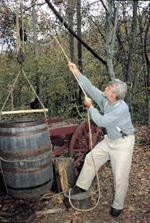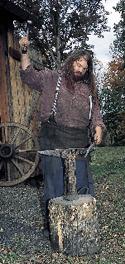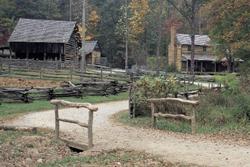|
Welcome to EXPLORE PARK
By Emily Grey, Contributing
Writer
From a morning in the 17th
century to an afternoon of fishing on the Roanoke River, a day in this
historical treasure is truly out of the ordinary.
It�s late October, circa 1671. Companions and this writer tread upon
a shady trail to the village of the Monacan people. Women and children of
this eastern woodland culture tend staple crops of squash, corn and beans.
Men use stones, shells and bones found along the vast floodplain and the
Great Valley to adroitly create tools, garments and shelter. Inside a tall
tepee, a heaping pile of kindling sizzles while smoke rises steadily
toward a crisscross wooden apex. We watch as these Native Americans tell
stories, care for their elders and young, and laboriously prepare for
winter at this period of initial European contact.
History Comes to Life
Around a bend in the Old Wagon Road, the 1700s come to life. At the
Settler�s Cabin, women sew, cook and gather the fall harvest while men
repair their hewn-log abode. A few yards down the sylvan path colonial
woodsmen like Daniel Boone and Simon Kenton busily tan beaver and deer
hides at Longhunter Camp. They cheerfully swap hunting tales and other
adventures from the mysterious, beautiful Blue Ridge Mountains that lie
yonder.
Time marches into the mid-1800s and a beehive of diverse activities.
Pioneers scurry about the little rural settlement entertaining questions
and conversations related to their era. No need trying to discuss the
Internet or Pok�mon.
Farther up the village the indispensable, burly blacksmith hammers away
in his Spartan shop. Treacherous footpaths comprised of rocks, deep holes
and mud made early travel by wagon a constant burden.
We marvel at the unique architecture of the German double-crib
�bank� barn of the Houtz family. Used in large-scale commercial
farming, this structural type may still be viewed in the Shenandoah Valley
and Pennsylvania.
Our circular route leads to Kemp�s Ford one-room schoolhouse. At the
front of the class the impeccably groomed master is conducting class.
Students of varying ages suppress giggles at their teacher�s formal
demeanor and antiquated attire. He turns his back but hastily pivots
around. For fear of being called on or chastised for not paying attention,
we depart for another segment of the journey.

 |
|
UPCOMING
SPECIAL
EVENTS
June 9-10
Garden Festival
June 24
Subaru Bike Fest
June 30
July 4th Celebration
Sept. 1-3
Appalachian Folk Festival
Oct. 13-14
Life Along the Wagon Road
|
Heirloom gardens with an array of vegetables and a corn-crib
outbuilding capture our attention. A tantalizing whiff of fresh oven-baked
loaves drifts from the Hofauger Farmstead. Herbs, flowers and tobacco hang
from spacious beams in the kitchen of the two-story house. A pot of hearty
stew simmers by a crackling fire. The cook serves the repast to her
guests, but not to my party. After all, we are 21st-century intruders,
invisible to the 1850s family. Soon, time-warp travelers will heartily
dine in the frontier atmosphere of Brugh Tavern.
A young woman dyes yarn while another demonstrates hand weaving inside
the Loom House. Nineteenth-century Ossabaw Island hogs and Hog Island
sheep, which furnish the wool for the aforesaid tasks, are penned outside
the Wray Barn.
On to the Gristmill
There�s something indomitable and eternal about a gristmill. The six-
to eight-foot-high waterwheel was once America�s symbol of commerce.
Towns sprang up and flourished near them.
In the mid-1700s, local farmers marketed their milled flour in Roanoke
and Danville. In 1860, Richmond was the nation�s largest flour-milling
arena and Virginia was the �grain belt of the south.� Shipping
packaged and barreled flour to strategic seaports was crucial during the
Civil War.
The mid-19th-century 20-foot-wide replica at this park contains a set
of French and Virginia 36-inch millstones and 150 feet of wooden sluice
box. Formerly known as the Esom Slone Mill of Franklin County, the
historic structure was dismantled, relocated and reset in motion. Soon,
people can observe close-up as corn and other grains are ground. (At the
time of this writing the exhibit is being restored.) Hopefully, they will
appreciate the old gristmill and actively work to restore others.
Batteaumen on the Free River
 |
About 15 years ago, an archaeological team in Richmond uncovered the
remains of awesome river boats called batteaux (French word for boats).
These mighty, low-maintenance craft were the major means of navigation on
inland waterways in the late 18th and early 19th centuries. Typically,
rivers above the fall line were rocky and contained rapids. The batteau
was, in effect, a �whitewater cargo boat� which could be skillfully
maneuvered about the falls.
Perhaps the most intriguing attraction at Explore Park is the portrayal
of the batteauman. In the mid- to late 1800s, free slaves, armed with
documents to that effect, navigated rough oak-framed batteaux down the
Roanoke River to distant ports of trade.
These vessels and their operators, mostly free African-Americans,
contributed substantially to the development and livelihood of Central
Virginia. The exhibit reveals the importance of river routes in commerce
prior to railroads and highways. It also gives a sense of the precious
liberty and movement enjoyed by free blacks.

 |
Adept helmsmen courageously steered these boats, built by farmers and
laden with tobacco, iron ingot, coal, wheat, corn and flour, to Richmond,
Lynchburg and other ports. The rugged batteaux were generally used only
for one trip. After reaching a destination, most of them were disassembled
and the lumber was sold. The boatmen often walked hundreds of miles back
to camp or their small abodes.
Soon to be featured along the banks of the Roanoke will be the
Batteauman�s Cabin. This 20-by-16-foot pine log building with stone
chimney will depict the simplicity of the boatman�s home life.
�When visitors leave Explore Park after viewing the batteau or riding
aboard it, ... I hope they feel hunger ... to know more about the human
side of the African-American experience in the time of slavery. There are
wounds to be healed and stumbling blocks to be made into stepping
stones,� says Aletha Bolden, executive director of Harrison Museum of
African-American Culture.
|
READY TO EXPLORE?
Address:
Explore Park
P. O. Box 8508
Milepost 115 on Blue Ridge Parkway
Roanoke, VA 24014-0508
Phone: (540) 427-1800
Fax: (540) 427-1880
Web Site: www.explorepark.com
E-mail: [email protected]
Directions:
From I-81 take exit 143 and then I-581/ US 220 for 12 miles. Turn north
on the Blue Ridge Parkway to Milepost 115 and continue about seven miles.
Seasonal Times:
April, Fri. & Sat., and May-Oct. 31, 2001, 10 a.m.-6 p.m.; Sun.
Noon-6 p.m.
Arthur Taubman
Welcome Center:
Open
April, Mon.-Thurs. 9:30am - 12:30pm; Fri. & Sat. 9:30am
- 5:30pm;
Sun. 11:30am-5pm
May-Oct., Mon.-Sat. 9:30am-5pm;
Sun. 11:30 am-5pm
Ask about in-season tours and the November-through-March Outreach
Program for school groups and in-service scientific certification for
teachers and park membership benefits.
Admission:
Adults (19-54) $8
Students (6-18) $4.50
Children 5 & under FREE
Seniors (55+) $6
Recreational Passes:
Day Bike only $3 (all ages per bike)
Fishing only $3 (all ages)
Nearby Superb Lodging:
CrossTrails B & B
Bill & Katherine Cochran, Innkeepers
5880 Blacksburg Rd.
Catawba, VA 24070
Phone: (540) 384-8078
Web site: www.crosstrails.com
E-mail: [email protected]
|
Nestled at the end of a short, secluded country lane sits the lovely
Mountain Union Church. Like many other dated buildings at Explore Park,
this 1880s Greek-Revival structure was moved from a far-off site.
Suddenly, the Vis-a-vis, an authentic 19th-century horse-drawn
carriage, pulls up to the chapel door. What an appealing place for a
memorable wedding, anniversary or other romantic or religious occasion.
Outdoor Play
Newly created 1,100-acre Explore Park offers sundry
outdoor recreation, like six easy-to-moderate miles of self-guided hiking
trails, mountain biking on Subaru-sponsored tracks and fishing in the
Roanoke River at Back Creek (The Point). Tangent Outfitters provides canoe
and kayak lessons with gear included in the rental fee.
Atop a grassy knoll overlooking the lovely river is
Shenandoah Life
Picnic Pavilion. This is an ideal locale for clubs, reunions and church
gatherings.
On certain weekends wagon rides and seasonal naturalist hikes are
available. The park is currently working with the Wild Turkey Federation
to establish feeding plots and a viewing platform above the river.
Arthur Taubman Welcome Center is the definitive post to become familiar
with the park. Next door, an interpretive building focusing on
transportation of the Roanoke Valley and Blue Ridge Parkway is targeted to
open later this year. Tickets to most events held at Explore can be
purchased at Taubman. The Blue Ridge Treasures Gift Shop, located at the
Welcome Center and the Rawanoke Trading Company, displays an unusual
assortment of historical mementos often manufactured on the grounds.
�Explore Park should be a regional showplace for recreational and
environmental education facilities,� explains Director Roger Elmore.
�It has the potential to be a major destination near the Blue Ridge
Parkway. It should be a catalyst for many things and for people to realize
that the Roanoke Valley has a lot to offer.�
|